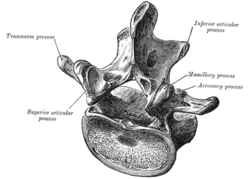Process (anatomy)
From Wikipedia, the free encyclopedia

In anatomy, a process (Latin: processus), or apophysis, is a projection or outgrowth of tissue from a larger body.[1] For instance, in a vertebra, a process may serve for muscle attachment and leverage (as in the case of the transverse and spinous processes), or to fit (forming a synovial joint), with another vertebra (as in the case of the articular processes).[2]
Examples
Examples of processes include:
- The many processes of the human skull:
- The mastoid and styloid processes of the temporal bone
- The zygomatic process of the temporal bone
- The zygomatic process of the frontal bone
- The orbital, temporal, lateral, frontal, and maxillary processes of the zygomatic bone
- The anterior, middle, and posterior clinoid processes and the petrosal process of the sphenoid bone
- The uncinate process of the ethmoid bone
- The jugular process
- The alveolar, frontal, zygomatic, and palatine processes of the maxilla
- The ethmoidal and maxillary processes of the inferior nasal concha
- The pyramidal, orbital, and sphenoidal processes of the palatine bone
- The coronoid and condyloid processes of the mandible
- The xiphoid process at the end of the sternum
- The acromion and coracoid processes of the scapula
- The coronoid process of the ulna
- The radial and ulnar styloid processes
- The uncinate processes of ribs found in birds and reptiles
- The uncinate process of the pancreas
- The spinous, articular, transverse, accessory, uncinate, and mammillary processes of the vertebrae
- The trochlear process of the heel
- The appendix, which is sometimes called the "vermiform process", notably in Gray's Anatomy
See also
Notes
References
- Dorland's Medical Dictionary
This article is issued from Wikipedia. The text is available under the Creative Commons Attribution/Share Alike; additional terms may apply for the media files.